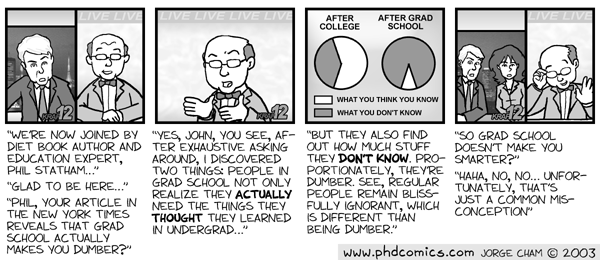Yes!
Science is “difficult” and “boring”, and not related to the real life
sometimes. A lot of people have this point view, even including scientists. The
emphasis of science is bunches of trials, formulas, protocols and data. People
who have little or no educated in science, could not see the relevance between
science researches and their daily life. The barriers to communicating between
scientists and the public are quite great and sometimes can cause serious
problem. And when the problem comes out, somebody needs to stand out and take
the responsibility. The scientists blame the journalists that they are careless
in their reporting, are sensationalized about the stories, and overstate a
scientific finding. Journalists, in turn, claim the science community limiting
access to information, building barriers to the public, and misguiding the
press and the public. Therefore, the public become more skeptical when they receive
information from the media and scientists. Even they are told by the truth,
sometimes they doubt it. This is a vicious circle, and in my opinion, it is not
possible to eliminate the miscommunication in science. In the relationship
among Scientists-media-public, there are lots of space for miscommunication in
science. It is really like three different cultures and cross together. They do
have similar factor which is English spoken. However, one language could have
multiple meanings within different cultures.
If
there is no way to take away the miscommunication, what should we do then? The simple
answer is “to enhance communication” and “know your audience”. We already knew
this, of course, but how? Here are some suggestions to make effective science
communication from different research papers (Stocklmayer, Shuchman, Ransohoff):
Remove
as much mathematics and formula as you can. Most people do not like math, and we
know this.
The
language you are using should be simple, as straightforward as possible. It
doesn’t necessarily mean the words but the vocabulary should be easy to
understand. Science is already difficult enough without having to think about
the words.
Possible
alternative conceptions could be another good choice as well. Use examples,
stories, or graph to explain complex process for your research. It will rise
the interests and attention from the media and the public.
Put
more efforts on finding good introductory “hooks”. This is the first and
important step to attract your audience and keep them stay further.
At
last, Keep it simple is always the key.
And
for the media, they have something to do as well.
Make
more open discussion instead of closed discussion of research could be helpful
to prevent sensationalism.
Media
should make efforts equally in negative and positive studies. The media do not
mention negative studies because sometime they are not inconsequential.
However, as a result, the scientists become less likely to submit the negative
results for publication because the journals do not want to publish them. This
could cause inaccurate reporting.
Media
should provide access to experts who can assist journalists to place correct
and new information in the proper text. Usually, the major source of the reporting
story are the researchers themselves. It is helpful to speak to someone who can
criticize the work before release the report.
The
media should easily explain and address concerns that some research data will
be misinterpreted by the media. This could happen in situations like sometimes
the science community does not want to discuss problems publicly for some
reasons or fears that journalists will not understand the issues. However,
withholding the information may cause even greater misunderstanding.
-Harry Zhao Yuanfeng
Stocklmayer, S. M.,
Gore, M. M., & Bryant, C. R. (Eds.). (2001). Science
communication in theory and practice (Vol. 14). Springer.
Shuchman, M., &
Wilkes, M. S. (1997). Medical scientists and health news reporting: a case of
miscommunication. Annals of Internal Medicine,126(12), 976-982.
Ransohoff, D. F.,
& Ransohoff, R. M. (2000). Sensationalism in the media: when scientists and
journalists may be complicit collaborators. Effective clinical practice: ECP, 4(4), 185-188.





